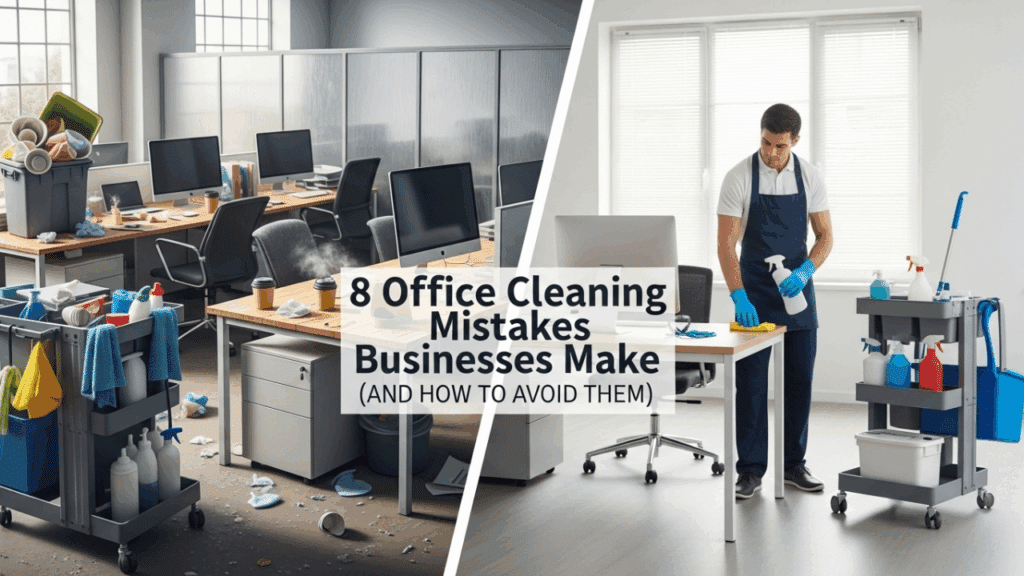Most people in Austin think “Austin office cleaning services” just means wiping desks and running the vacuum. It keeps your workspace safe, healthy, and productive.
When an office feels clean, employees focus better. They take fewer sick leaves. And clients? They will notice your clean office. Studies show that the number of bacteria on your desk is 400 times higher than on your toilet seat. Wild, right?
Without regular disinfection, germs spread fast. It starts with one keyboard and ends up all over the breakroom. That’s why routine commercial cleaning Austin plays an important role. It protects your employees’ health and your company’s reputation.
Every business makes cleaning mistakes. We’ve seen them all. So let’s go through the top 8 office cleaning mistakes and how you can avoid them.
1. Using Too Many (or the Wrong) Cleaning Products
We’ve witnessed supply closets resembling mini supermarkets, stocked with sprays, wipes, gels, and powders, each promising “maximum shine.” The fact is, the vast majority of them do exactly that.
The problem? Floors are ruined due to the use of improperly mixed cleaning chemicals or those not meant for them. Also, what can aggressive ingredients do? They can
- Dull furniture
- Damage metal
- Turn the floor slippery.
Stick to what works. A good all-purpose cleaner, a disinfectant, a glass cleaner, and a floor-safe solution are hard to beat for most offices. And if your business is working to be greener, opt for green cleaning supplies. They’re safer for your team and don’t leave the heavy chemical smell that lingers all day.
2. Forgetting High-Touch Areas (the Germ Magnets)
Light switches. Door handles. Elevator buttons. Keyboards.
You’d be shocked at how many people touch them every day and how few cleaners remember to wipe them.
These small spots are germ magnets. And yes, skipping them can spread colds, the flu, or worse.
Make it a habit: disinfect high-touch areas daily. A quick spray and wipe can stop half the sickness that passes around the office.
We always tell clients: if you’re cleaning an area someone touches every day, treat it like gold. Clean it like your health depends on it (because it does).
3. No Cleaning Schedule
One of the most common mistakes workplaces make is cleaning only when they think things are dirty. Without a set plan, dust, dirt, and germs accumulate quickly and build up in hard-to-see places like behind printers and under desks.
So what is the fix? Establish a formal cleaning routine such as
- Daily cleaning
- Weekly cleaning
- Monthly cleaning
- A contract janitorial service
A cleaning schedule that is well thought out will lower the chances of getting sick, maintain the cleanliness of the air, and save costs.
4. Cleaning With Dirty Tools
We’ve seen people using the same mop water for three rooms or the same rag for desks and bathrooms. After every usage, even your mop bucket needs to be rinsed. Bacteria grow in standing water more quickly than you may imagine.
You’re spreading germs rather than cleaning if your instruments are filthy.
- Change mop water often.
- Wash cloths daily.
- Empty vacuum bags before they overflow.
Invest in color-coded tools to keep cross-contamination low and hygiene high. such as
- One color for bathrooms,
- Another for desks
- Another for kitchens.
5. Overlooking Hidden Spots
The vast majority of offices have the appearance of cleanliness. Official workspaces are orderly, floors tend to be shiny, but pull out a filing cabinet and you will find yourself staring at a dust colony thriving underneath it. Other spaces are frequently ignored for months on end, such as
- Beneath furniture
- Behind machines
- Inside vents or ducts
The dust is not just sitting there; it’s also dispersing and impacting air quality. That means deep cleaning every few weeks. Pull furniture away from walls, vacuum beneath, and clean vents. You will then notice that your space smells fresher and that your staff can actually breath better.
6. Clutter Everywhere
Clutter kills cleaning. Stacks of paper, discarded lunch boxes, and a knot of wires are all things that must be cleaned. We have seen offices in which office cleaners dedicate half their hours to moving stuff instead of cleaning. It’s all about a clean desk policy.
Everyone should clear their workspace each day, such as
- No pile of paper
- No coffee cups
- Nothing but a computer and keyboard
- Empty the trash cans and replace liners.
7. Forgetting to Empty Trash Regularly
You wouldn’t believe how many people forget this step. Garbage is putrefying quickly, especially in kitchens or around desks. A trash can can fill up fast and begin to stink. Leaving garbage for too long can draw all sorts of nasty bugs and unwanted bacteria.
Daily removal, replacement of liners, and a quick disinfecting spray can help to combat this problem. Hallway and printer-area bins can become full quite quickly and should be emptied regularly, too.
8. Neglecting Air Vents and Filters
You can’t see air vents and filters because these are the out-of-sight-out-of-mind areas. These are among the leading sources of musty odors and crappy indoor air quality.
If you have dust and debris in your vents, it’s like turning your HVAC system on overdrive and distributing allergens all through the office. And that is bad news for people with allergies or asthma.
For air vents, a deep clean every couple of months is good enough; filters should be replaced regularly. That’s a basic act of maintenance, but it can make a significant difference in air freshness.
Final Thoughts
An orderly office isn’t a design statement to impress visitors; it’s there for your team’s health and morale. Dirt and germs can lower productivity much more than you’d think. Cleaning is part science, part routine, and a little bit of pride.
You can be consistent about that and use the tools and stop being lazy about it; it works instantly. And if it all starts to seem like too much, hire some cleaning experts who know what they’re doing. It’ll save you time and frustration to bring somebody in who cleans for a living.

